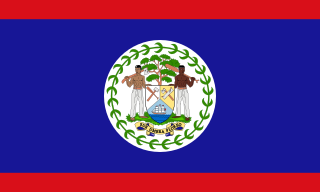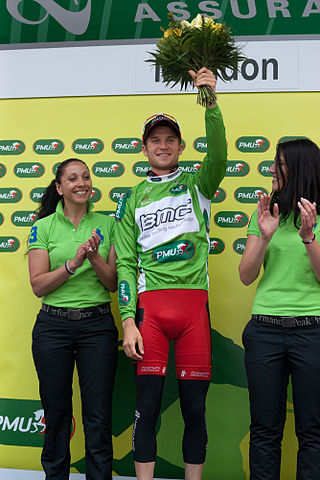
Belize is a country on the north-eastern coast of Central America. It is bordered by Mexico to the north, the Caribbean Sea to the east, and Guatemala to the west and south. It also shares a water boundary with Honduras to the southeast.

Xunantunich is an Ancient Maya archaeological site in western Belize, about 70 miles west of Belize City, in the Cayo District. Xunantunich is located atop a ridge above the Mopan River, well within sight of the Guatemala border – which is 0.6 miles (1 km) to the west. It served as a Maya civic ceremonial centre to the Belize Valley region in the Late and Terminal Classic periods. At that time, when the region was at its peak, nearly 200,000 people lived in the Belize Valley.

.bz is the Internet country code top-level domain (ccTLD) for Belize. It is administered by the University of Belize.
The Holy Saturday Cross Country Cycling Classic is a one-day amateur cycling race held in Belize every year during the Easter holidays. It is Belize's biggest cycling event and has begun to be recognized internationally.
The Belize Premier Football League (BPFL) (Caribbean Motors Cup) was the premier division of association football in Belize sanctioned by the Football Federation of Belize. The league disbanded in 2011 after the merger with the Super League of Belize to create a new top league in Belize, the Premier League of Belize.

Sports have had an important role in Belizean culture. While Belize has never been an international sporting power, the nation's athletes have had some international success. Sports in the country are plagued by a lack of finance and sporting facilities, and there is little emphasis on sports as an integral part of national culture and pride. Nevertheless, sports continue to bring Belizeans together on and off the field.
The KREM New Year's Day Cycling Classic is a single day road cycling race held in Belize since 1991 on New Year's Day, January 1, and is thus the first race on Belize's cycling calendar. The race was restricted to elite and junior men until 2001, when females became eligible to ride. It is considered the second most prestigious race in Belize after the Holy Saturday Cross Country Cycling Classic.

Uxbenka is a pre-Columbian Mesoamerican archaeological site located in Belize's southernmost district of Toledo. An urban settlement of the pre-Columbian Maya, it is the earliest-known Maya polity in the southern Belizean lowlands, with evidence of occupation dating to the Early Classic period of Mesoamerican chronology. It is one of five major Maya sites in this region, whose archaeological sites also include Nim Li Punit and Lubaantun. Settlement of Uxbenka has been suggested to have occurred originally by Peten peoples. The site is approximately 40 square kilometers in size, and Uxbenka is referred to as a medium-sized polity ). Uxbenka rose shortly after the expansion of another Maya site, Tikal. The site is thought to have been first inhabited during the late Preclassic period.
Michael Dennison Lewis is a Belizean professional racing cyclist, who twice competed for his native country at the Summer Olympics: 1988 and 1992.

Belize first participated at the Olympic Games in 1968 and has sent athletes to compete in every Summer Olympic Games since then, except when they participated in the American-led boycott of the 1980 Summer Olympics. The nation has never participated in the Winter Olympic Games. From 1968 to 1972, Belize was known by its colonial name of British Honduras.

Chad Beyer is an American former professional road racing cyclist, who rode professionally between 2009 and 2017 for the BMC Racing Team, Competitive Cyclist Racing Team, Champion System, 5-hour Energy, Lupus Racing Team and Hangar 15 Bicycles teams. Beyer's most notable achievement was during the 2010 Tour de Romandie, when he won the Points Classification.
Pusilhá is an archaeological site in Belize. The location of this Late Classic Maya urban complex, along the east and west flow of trade, made the city a major transfer point for economic activities in the whole region. In addition, the city gave archaeologists a historical view of a secondary Maya site. Large and extended excavation efforts have changed the overall picture of Maya social and political relationships between larger and smaller cities and challenged the prevailing view of conquest and absorption of smaller cities into the larger cities in the region. The research conducted at Pusilhá began in 1927 and continues to this day.
Baking Pot is a Maya archaeological site located in the Belize River Valley on the southern bank of the river, northeast of modern-day town of San Ignacio in the Cayo District of Belize; it is 6 kilometres (3.7 mi) downstream from the Barton Ramie and Lower Dover archaeological sites. Baking Pot is associated with an extensive amount of research into Maya settlements, community-based archaeology, and of agricultural production; the site possesses lithic workshops, and possible evidence of cash-cropping cacao as well as a long occupation from the Preclassic through to the Postclassic period.
The Central American Cross Country Championships are an annual Cross country running competition organized by CADICA for athletes representing the countries of its member associations. They were established in 2007. Races are featured for senior (Mayor), junior, youth, and two age groups for both male and female athletes.

Pacbitun is a Maya archaeological site located near the town of San Ignacio, Belize, in the Cayo District of west central Belize. The modern Maya name given to the site means “stone set in earth”, likely a reference to multiple fragments of stone monuments. The site, at about 240 m above sea level, is one of the earliest known from the southern Maya Lowlands, and was inhabited for almost 2000 years, from ca. 900 BCE to 900 CE. Strategically, it straddles a territory of rolling, hilly terrain between the Mountain Pine Ridge and the tropical forest covered lowlands of the Upper Belize River Valley.

Caracol is a large ancient Maya archaeological site, located in what is now the Cayo District of Belize. It is situated approximately 40 kilometres (25 mi) south of Xunantunich, and the town of San Ignacio, and 15 km (9.3 mi) from the Macal River. It rests on the Vaca Plateau, at an elevation of 500 m (1,600 ft) above sea-level, in the foothills of the Maya Mountains. Long thought to be a tertiary center, it is now known that the site was one of the most important regional political centers of the Maya Lowlands during the Classic Period. Caracol covered approximately 200 square kilometres (77 sq mi), covering an area much larger than present-day Belize City, the largest metropolitan area in the country, and supported more than twice the modern city's population.

Paolo Simion is an Italian former professional racing cyclist, who competed as a professional from 2015 to 2021. He rode in three editions of the Giro d'Italia.
Lower Dover is a Maya archaeological site in the Belize River Valley. It is located on the grounds of the Lower Dover Field Station & Jungle Lodge, in Unitedville, Cayo District, Belize. The site is bordered by the Belize River to the north, Upper Barton Creek to the west, Lower Barton Creek to the east, and the Western Highway to the south. Lower Dover is one of several Maya archaeological sites in the area; it is across the Belize River from Barton Ramie, 3 kilometers west of Blackman Eddy, and 6 kilometers east of Baking Pot.







